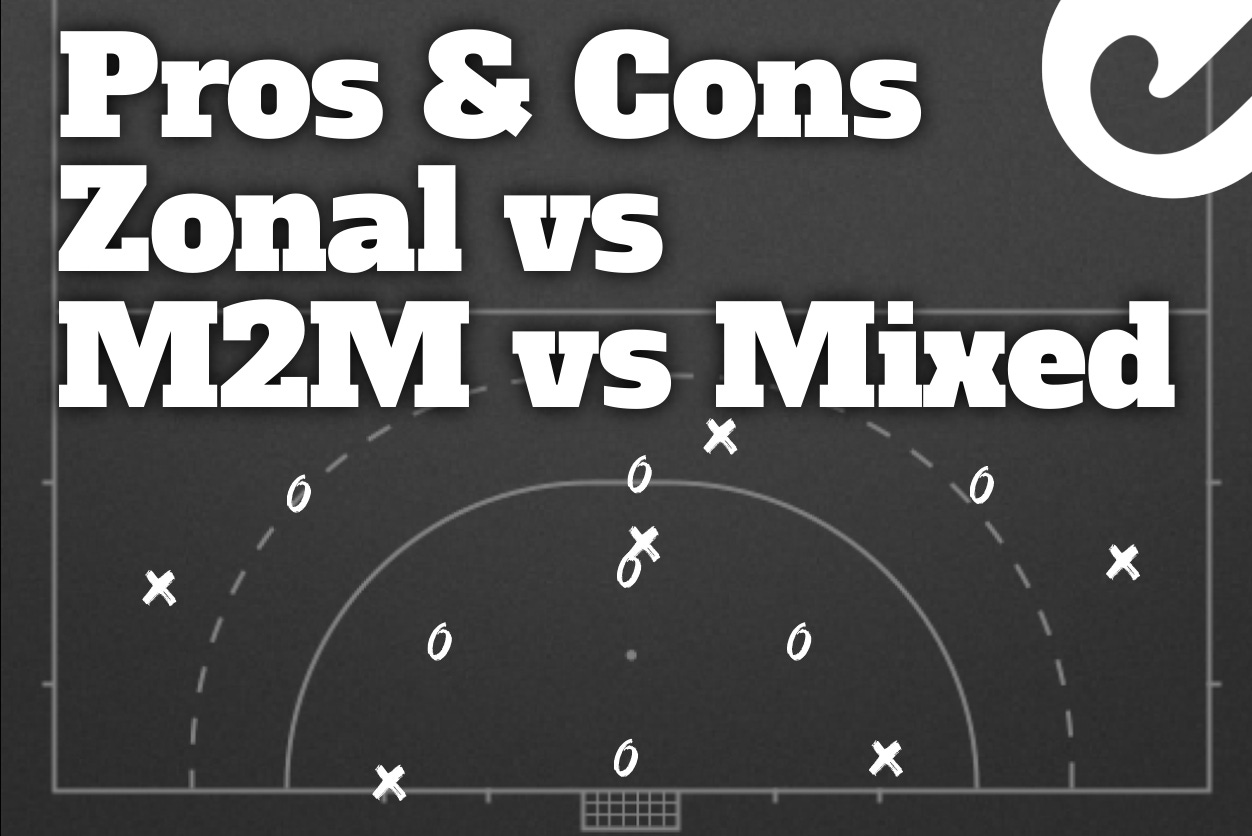Pros and Cons of Zonal, Man-to-Man and Mixed Defense Systems
Advantages, disadvantages and when to choose what defensive system in field hockey
Based upon the masterclasses delivered by several top coaches, we wanted to list you the advantages & disadvantages of a zonal, a man to man defense or a mixed system. Also we’ll go into which system to choose when…
Zonal Defense
Advantages:
Energy Efficiency: A well-structured zone defense allows players to conserve energy by focusing on controlling space rather than chasing opponents. Danny Kerry highlighted this as a key benefit, particularly in high-intensity matches where physical demands are significant.
Structure and Compactness: It maintains a solid defensive shape, making it harder for opponents to penetrate centrally. This was a hallmark of Belgium’s defensive success during the 2018 World Cup, where their zonal system frustrated even top teams like Australia .
Flexibility in Transition: Zones allow for smoother transitions between defense and attack, as players are already positioned to intercept and counterattack when possession is regained 6.
Adaptability to Overloads: In a zone, defenders can adjust to numerical overloads by shifting collectively, as Kwan Browne emphasized in his masterclass on zonal defense.
Disadvantages:
Vulnerability to Skilled Opponents: Teams with strong technical skills and quick passing can exploit gaps in the zone, especially if the defensive structure isn’t compact enough.
Decision-Making Challenges: Players must decide when to stay in their zone and when to track a leading player, which can cause confusion if not trained properly.
Requires High Tactical Discipline: A zonal system demands excellent communication and understanding among players to maintain its integrity.
Man-to-Man Defense
Advantages:
Direct Accountability: Each player is responsible for marking a specific opponent, which simplifies individual roles and responsibilities.
Aggressive Pressure: It allows for tighter marking and immediate pressure on the ball carrier, disrupting the opponent’s rhythm.
Effective Against Static Play: Man-to-man systems work well against teams that rely on predictable patterns or slower build-up play.
Disadvantages:
Physically Demanding: Players must constantly track their opponents, which can lead to fatigue, especially against teams with high off-ball movement.
Vulnerability to Overloads: If the opponent creates numerical superiority in certain areas, it can leave gaps elsewhere.
Risk of Disorganization: If one player loses their marker, it can disrupt the entire defensive structure.
Mixed Systems
Advantages:
Best of Both Worlds: Combines the structure of a zone with the aggressive pressure of man-to-man marking, offering flexibility to adapt to different situations.
Adaptability: Allows teams to switch between systems based on the phase of play or the opponent’s tactics. Danny Kerry noted that modern hockey increasingly features hybrid systems, where teams transition between zone and man-to-man within a single quarter.
Targeted Pressure: Defenders can focus on marking key players while maintaining overall shape.
Disadvantages:
Complexity: Requires a high level of tactical understanding and communication to execute effectively.
Training Time: Players need extensive practice to master the transitions between systems.
Risk of Miscommunication: If players are unclear about their roles, it can lead to breakdowns in the defensive structure.
Choosing a Defensive System
Based on Your Team’s Characteristics
Zonal Defense:
When to Choose: If your team is disciplined, tactically aware, and physically less dominant. A zone allows players to conserve energy and focus on controlling space rather than chasing opponents.
Why: It’s ideal for teams that excel in reading the game, maintaining compactness, and working collectively. For example, Belgium’s success with a zonal system was rooted in their ability to stay organized and deny central spaces.
Man-to-Man Defense:
When to Choose: If your team is physically fit, aggressive, and thrives on individual battles.
Why: It’s effective for teams with strong one-on-one defenders who can handle the physical demands of tracking opponents throughout the game.
Mixed Systems:
When to Choose: If your team has a high tactical IQ and the ability to adapt to different situations.
Why: A mixed system provides flexibility, allowing you to apply zonal principles in some areas while using man-to-man marking to neutralize key threats.
Based on the Opponent’s Characteristics
Zonal Defense:
When to Choose: Against teams that rely on structured build-up play or have strong individual attackers. A zone can disrupt their rhythm and force them into less dangerous areas.
Why: It denies central spaces and forces the opponent to take risks, increasing the likelihood of turnovers.
Man-to-Man Defense:
When to Choose: Against teams with predictable patterns or slower ball movement.
Why: Tight marking and aggressive pressure can disrupt their play and force errors.
Mixed Systems:
When to Choose: Against versatile teams that can switch between styles or have a mix of technical and physical players.
Why: A hybrid approach allows you to adapt to their strengths and weaknesses, applying pressure where needed while maintaining overall structure.
Final Thoughts
The choice of defensive system depends on a combination of your team’s strengths, the opponent’s characteristics, and the context of the match. As Danny Kerry emphasized, the key is to maintain flexibility and adaptability, as modern hockey often requires teams to transition between systems within a single game.
Enjoy your hockey !
PS: Always curious to learn your thoughts on this 👇
Some of the sources:
Closing and tackling in a zone defence
A masterclass by Danny Kerry (ENG) on closing & tackling in a zone defence. A topic that challenged him when he took over the English and GB national men’s team and introduced new tactics in the lead up to the Tokyo Games.
Long Corner Defence
On September 17, 2021 we hosted another coach chat. Kwan Browne talked to us about the long corner defence. He is a former international player for Trinidad & Tobago.







